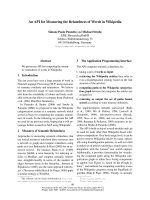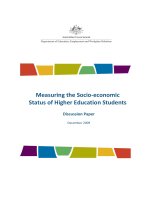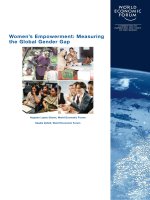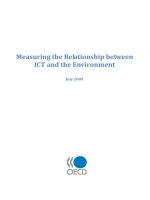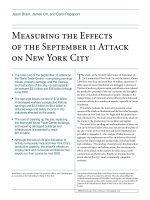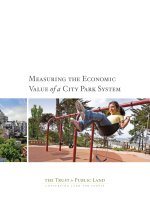Sustainability indicators measuring the immeasurable
Bạn đang xem bản rút gọn của tài liệu. Xem và tải ngay bản đầy đủ của tài liệu tại đây (1.47 MB, 240 trang )
Sustainability Indicators
Sustainability Indicators
Measuring the Immeasurable?
Second edition
Simon Bell and Stephen Morse
London • Sterling,VA
First edition published by Earthscan in the UK and USA in 1999
This second edition first published in 2008
Copyright © Simon Bell and Stephen Morse, 2008
All rights reserved
ISBN-13:
978-1-84407-299-6
Typeset by MapSet Ltd, Gateshead, UK
Printed and bound in the UK by TJ International Ltd, Padstow, Cornwall
Cover design by Susanne Harris
For a full list of publications please contact:
Earthscan
Dunstan House, 14a St Cross Street
London, EC1N 8XA, UK
Tel: +44 (0)20 7841 1930
Fax: +44 (0)20 7242 1474
Email:
Web: www.earthscan.co.uk
22883 Quicksilver Drive, Sterling,VA 20166-2012, USA
Earthscan publishes in association with the International Institute for Environment
and Development
A catalogue record for this book is available from the British Library
Library of Congress Cataloging-in-Publication Data
Bell, Simon, 1957 July 30–
Sustainability indicators : measuring the immeasurable? / Simon Bell and Stephen
Morse. – 2nd ed.
p. cm.
Includes bibliographical references and index.
ISBN-13: 978-1-84407-299-6 (pbk.)
1. Environmental indicators. 2. Sustainable development–Statistical methods. 3.
Environmental monitoring–Statistical methods. I. Morse, Stephen, 1957– II.Title.
GE140.B45 2008
338.9'27–dc22
2008003017
The paper used for this book is FSC-certified and
totally chlorine-free. FSC (the Forest Stewardship
Council) is an international network to promote
responsible management of the world’s forests.
Contents
List of Figures,Tables and Boxes
List of Acronyms and Abbreviations
Foreword
Acknowledgements
ix
xiii
xvii
xxi
Part I The Bad Application of Good Science?
1
2
Sustainability and Sustainability Indicators
Introduction and objectives
Two roots of sustainability
The meaning of sustainability
Space and time in sustainability
System quality
Sustainability in practice
Indicators of ecosystem health
Sustainability indicators and indices
Sustainability indicators: A realistic and reasonable approach
to measuring sustainability?
3
3
6
10
14
17
20
22
27
Sustainability Indicators in Practice
Introduction and objectives
Maximum sustainable yield
Problems with applying maximum sustainable yield
Maximum sustainable yield as a sustainability indicator
Sustainability indicators in marine ecosystems:
The AMOEBA approach
Conclusions
45
45
48
55
60
41
62
69
vi
3
Sustainability Indicators
Indicators, Cities, Institutions and Projects
Introduction and objectives
Sustainable communities
Institutional sustainability
Projects, appraisal and sustainability
75
75
78
84
92
Part II The Application of Grounded and
Pragmatic Systemisism
4
5
6
Paradigms and Professionals
Introduction and objectives
Changes in thinking: From science to systems
The demise of narrow scientism
Systems approaches to problem-solving
A range of systems approaches
A problem-solving approach:The soft systems method
Problem description:The learning organization approach
Appraisal:The participatory rural appraisal approach
Project handling:The logframe approach
An overview of systemic approaches
New definitions and new thinking: Holism, eclecticism,
systemisism and future casting
Emerging premises for SI development
101
101
104
106
110
114
115
117
119
122
125
Projects and Sustainability Indicators
Introduction and objectives
The project scenario for SIs
The stakeholder scenario for SIs: Participation and coalition
Accommodating multiple views of sustainability
Introducing the systemic sustainability analysis idea:
The Imagine Approach
133
133
136
140
142
Imagine: An Example of a Systemic Sustainability Analysis
Introduction and objectives
Step 1:The beginning of the process – understand the context
Step 2: Identify the main SIs and the band of equilibrium
Step 3:The development of AMOEBA and scenario-making
Step 4: Review and meta-scenario-making
Step 5: Publicity, publicizing and marketing the message –
influencing policy
Conclusion: Renewing the cycle
153
153
157
170
181
187
126
131
147
189
191
Contents
vii
Part III Where Next? Humility and Honesty
7
Sustainability Indicators: The Rhetoric and the Reality
Introduction and objectives
Managing expectation in the projectified world order
Organic and empowering approaches compared to inorganic
and dehumanizing approaches
Culture change
The essential need for reflective practice
Future research priorities
Epistemological questions
The systemic approach
Participatory SIs in social development projects and research
Assessment of SIs
References
Index
195
195
197
199
201
203
204
205
206
206
206
209
223
List of Figures,Tables and Boxes
Figures
F.1
C.1
1.1
1.2
1.3
1.4
1.5
1.6
1.7
C.2
2.1
2.2
2.3
2.4
2.5
2.6
2.7
2.8
2.9
2.10
C.3
C.4
4.1
4.2
Overview of the book
Chapter 1 in context
The roots of the modern view of sustainability
System quality and sustainability
Importance of the reference point for gauging sustainability
The two broad approaches to using environmental indicators
Fish distribution in the Cynon River system in South Wales, UK
Change in biodiversity (Shannon–Wiener Index, H) along the
River Cynon in South Wales
The concept behind sustainability indicators (SIs)
Chapter 2 in context
Examples of population growth curves
Example of an age distribution
Main elements contributing to population change
The concept of maximum sustainable yield in harvesting a
population
The Schaefer model employed to determine MSY based on the
fishery yield for a particular fishing effort
Population growth curves based on the equation in Box 2.4
Schaefer model fitted to data from the Peruvian anchovy fishery
Example of an AMOEBA approach to presenting sustainability
indicators
Biomass of trout and bullhead and numbers of midges at four
sampling stations on the River Cynon relative to station C1
(the reference condition)
Biomass of trout and bullhead and numbers of midges at four
sampling stations on the River Cynon relative to station C2
(the reference condition)
Chapter 3 in context
Chapter 4 in context
A continuum of research approaches
A systems view of a particular context
xix
4
7
13
16
23
25
26
28
46
50
52
52
53
53
56
58
65
67
68
76
102
105
113
x
Sustainability Indicators
4.3
4.4
4.5
4.6
4.7
4.8
C.5
5.1
5.2
5.3
5.4
5.5
5.6
5.7
5.8
5.9
C.6
6.1
6.2
6.3
6.4
6.5
6.6
6.7
6.8
6.9
6.10
6.11
6.12
6.13
6.14
6.15
6.16
6.17
6.18
6.19
6.20
6.21
6.22
C.7
7.1
7.2
A reductionist view of a particular context
Axis for comparing systems approaches
The soft systems method
The reinforcing loop (snowball)
Three pillars of PRA
The four systemic approaches
Chapter 5 in context
The use people make of sustainability indicators
The blueprint project cycle(s): Relationship between the phases
of project formulation and the traditional project cycle
The process or ‘adaptive’ project approach
Project approaches and the spectrum of thinking about
problem-solving
Venn diagram of participant group overlap
Multiple views on a project’s goal
A systems view of participation
What are the main SIs that we will make use of?
A sustainability indicator AMOEBA
Chapter 6 in context
The five steps of the Systemic Sustainability Analysis approach
The five steps of the Imagine approach
SWOT analysis of the mood of a university department
concerning a project to develop consultancy within the department
Quadrants with notes
Rich picture of a complex sustainability project context
A further rich picture of a complex sustainability project context
Single view of sustainability
Multiple views of sustainability
State and impact SIs
DPSIR indicators
Internal and external SIs
Relative controllability of internal and external DPR SIs
The River Cynon project and SIs
Different types of SIs evolving in the project
The SI learning cycle
A collection of ‘valid’ SIs
The SI continuum
Band of equilibrium for SIs
The equilibrium band: Drawing the SIs
Hand-drawn AMOEBA
Extending the AMOEBA over time
‘Promising land’ scenario AMOEBA from Slovenia
Chapter 7 in context
Equilibrium and agreed expectations
A learning cycle of further questions
113
114
115
119
122
126
134
135
136
137
138
143
144
146
148
150
154
155
156
158
158
160
161
164
165
171
171
172
172
173
173
174
177
180
181
182
183
184
188
196
198
205
List of Figures,Tables and Boxes
xi
Tables
1.1 The United Nations working list of indicators of sustainable
development (ISDs) based on Agenda 21 (Rio de Janeiro,
June 1992)
1.2 Some sustainability indicators proposed by Izac and Swift (1994)
for sub-Saharan African agro-ecosystems
3.1 Top ten key components of sustainable development by
100 households in a Scottish village, UK
3.2 The Norwich 21 set of SIs
3.3 Values of the Subsidy Dependence Index (SDI) for some
rural finance institutions
4.1 Defining features of systems
4.2 Comparison of systems and reductionist approaches
4.3 The five disciplines
4.4 An overview of the logical framework (LF)
4.5 Explaining logical frameworks
4.6 A partial logical framework expression of Norwich 21
5.1 Project: Blueprint and process
5.2 Participant stakeholder groups
5.3 Participant stakeholder groups in a Nigerian project
6.1 Stakeholder analysis spreadsheet
6.2 Developing the message for the customer
7.1 Problems and prizes of vulnerability
30
34
80
82
89
112
114
118
124
124
125
138
142
143
166
190
204
Boxes
1.1
1.2
1.3
1.4
1.5
1.6
1.7
2.1
2.2
2.3
2.4
Visions of sustainable agriculture
Some definitions of sustainability
Two different visions of sustainability
The Environmental Kuznets Curve (EKC)
A summary of the ten Bellagio Principles for gauging progress
towards sustainable development
The Shannon–Wiener Index (H) of biodiversity
The theory behind the calculation of the Total Factor Productivity
Index (TFP) of sustainability in tropical farming systems
The mathematical equations behind the population curve in
Figure 2.1(a)
The mathematical equation behind the population curve in
Figure 2.1(b)
An equation relating fishing effort to yield from a fishery
A population growth equation based on the assumption that the
size of the population is linked to that of the previous generation
9
10
14
19
22
27
39
51
51
54
57
xii
Sustainability Indicators
2.5 Calculation of ecological Dow Jones indices for three indicators
(trout and bullhead biomass and midge numbers) from the
River Cynon in South Wales
2.6 Two simple factors that complicate the use of the algae index
as an SI
3.1 Two indicators that can be employed to gauge the self-sufficiency
of development institutions in providing financial services to
resource-poor groups
4.1 Some of the techniques in participatory rural appraisal (PRA)
6.1 Some major elements of a workshop
69
72
88
120
163
List of Acronyms and Abbreviations
AMOEBA
ASC
BAAC
BCCI
BITAOC
BKK
BOD
BUD
CBA
CBI
DDS
DfID
DPR
DPSIR
DSD
DSIR
DSR
ECBA
EDJI
EEA
EKC
ESI
ESY
EU
FAO
FS
FSR
FSR/E
GB
GCM
GIS
general method for ecosystem description and assessment
(Dutch)
Academy for Sustainable Communities
Bank for Agriculture and Agricultural Co-operatives
(Thailand)
Belize Chamber of Commerce and Industry
beneficiaries, implementers, transformation, assumptions (or
worldview), owner and constraints
Badan Kredit Kacamatan (Indonesia)
biological oxygen demand
Bank Rakyat Indonesia Unit Desa (Indonesia)
cost–benefit analysis
Confederation of British Industry
Diocesan Development Services (Nigeria)
Department for International Development (UK)
driving force, pressure, response
driving force, pressure, state, impact, response
degree of sustainable development
driving force, state, impact, response
driving force, state, response
economic cost–benefit analysis
Ecological Dow Jones Index
European Environment Agency
Environmental Kuznets Curve
Environmental Sustainability Index
ecologically sustainable yield
European Union
United Nations Food and Agriculture Organization
financial services
farming systems research
farming systems research and extension
Grameen Bank (Bangladesh)
global climate model
geographic information systems
xiv
Sustainability Indicators
H
IISD
ISD
IUCN
LF
LISA
LO
M&E
MCA
MEY
MIS
MOV
MSY
N
NEF
NGO
ODA
OECD
OVI
P
PDR
PPP
PRA
PRAM
PSI
RRA
SCBA
SCP
SDI
SI
SSA
SSI
SSM
SWOT
TFP
TUC
UEA
UK
UN
UNEP
US
USAID
WCED
WEF
Shannon–Wiener Index
International Institute for Sustainable Development
indicator for sustainable development
World Conservation Union (formerly International Union for
the Conservation of Nature)
logical framework/logframe
low-input sustainable agriculture
learning organization
monitoring and evaluation
multi-criteria analysis
maximum economic sustainable yield
management information systems
means of verification
maximum sustainable yield
nitrogen
New Economics Foundation
non-governmental organization
Overseas Development Administration (now renamed DfID)
Organisation for Economic Co-operation and Development
objectively verifiable indicator
phosphorous
pressure, driving force, response
purchasing power parity
participatory rural appraisal
participatory and reflective analytical mapping
process SI
rapid rural appraisal
social cost–benefit analysis
Sustainable Cities Programme
Subsidy Dependence Index
sustainability indicator
Systemic Sustainability Analysis
state SI
soft systems approach or method
strengths, weaknesses, opportunities and threats
Total Factor Productivity
Trades Union Congress
University of East Anglia
United Kingdom
United Nations
United Nations Environment Programme
United States
US Agency for International Development
World Commission on Environment and Development
World Economic Forum
List of Acronyms and Abbreviations
WHO
WHOQOL
WWF
xv
World Health Organization
World Health Organization Quality of Life
World Wide Fund for Nature (formerly World Wildlife Fund)
Foreword
As we wrote in the first edition, this book remains the result or outcome of our
personal journeys through a great deal of literature and opinion on sustainability – but now this is tempered with experience and reflection. Although
both of us have spent many years working in development studies, Steve is an
applied biologist with a background in the scientific tradition, whereas Simon
defines himself as a systems thinker and action researcher with specific
experience in the field of information systems development and computing.
Both of us have come by separate routes to the current discussion relating to
sustainability; and without being dramatic, this book can still be described as
the fruit of a voyage of discovery.
For many years we have both been concerned, but from our different
perspectives, with the literature on sustainability and the discussions that this
literature has produced. On the one hand, we were worried by the numerous
attempts to try and ascribe exact ‘measures’ to sustainability (for instance,
sustainability = 42). On the other hand, it appeared that the politicians had
created a storm by picking up on the word sustainability, which was intended to
be the marker and driving force for the global development effort. Such an
emphasis intensified the need for definition and measurement so we could
assess our progress towards achievement (or not) of sustainability; and yet the
very holistic and anthropocentric essence of sustainability continues to elude
attempts at objective analysis and assessment. Managers love to ‘measure’ in
order to know that they have managed successfully; but so much of life is
immeasurable.
We came to the conclusion separately that in trying to tie down and
measure sustainability, surely the civic, academic and developmental communities were engaging in a futile exercise of measuring the immeasurable?
Although many have tried to quantify sustainability – with all the jargon and
apparent rigour of the objective and reductionist mindset of much of the
academic community – when looked at more closely, the approaches do not
seem to work or, worse still, we end up measuring things that can be measured
and not things that should be measured, if at all possible. Indeed, sustainability
is not a ‘thing’ that can be measured, and an element of circularity appears
inevitable: sustainability becomes defined by the parameters that can be
measured rather than the other way around. Our key premise is that the
xviii
Sustainability Indicators
approach to measurement is always based on an individual’s vision of sustainability, which in turn can be changed depending upon the measurement mindset.
Our concern grew in our analysis of theory and in our own practice as
consultants and researchers; despite being told by some colleagues in the early
days of writing the first edition that to critically evaluate sustainability indicators was ‘off the wall’, we decided to both map our understanding of the
sustainability indicator debate and to set out what we think might be a more
holistic, realistic, participative and systemic approach to gauging sustainability.
Now, in this new edition, we can further develop this theme by showing how
we have applied the methodology and reflected on our experience.
At the outset, we need to bring to the reader’s attention problems concerning the use of the words system and systemic. In the first three chapters of this
book, which briefly review the work of academics and practitioners in developing sustainability indicators, the word system is frequently used; however, this
is usually in a non-specific everyday sense – the word could be replaced with
‘related entities’ or even ‘things’! In Chapters 4 to 7 we use the words much
more specifically and provide definitions of what they mean in precise terms.
This book is both the outcome of a creative endeavour and the reflection of
the current debate on sustainability indicators. We offer our thoughts on the
discussion so far and suggest ways forward with humility. We both agree that
there will be great need for fuller discussion before the issue is in any way
resolved, and all we can hope to do is to contribute some personal insights.
The reader will find three distinct sections in the following pages:
1
2
Part I is a literature review on the use of sustainability indicators (SIs) in
development. Chapter 1 provides background to the issue of SI development; Chapter 2 focuses on examples of single and multiple SIs; and
Chapter 3 looks at institutional SIs and sustainable cities, and introduces the notion of using SIs in projects. Each of these topics can be
(and have been) the focus of a book in itself; thus, the aim is to give the
reader an overview of issues rather than an exhaustive review of all of
the literature.
Part II sets out an alternative theory: a systemic manner for the development of SIs. In Chapter 4 the theory – Systemic Sustainability Analysis
(SSA) – is introduced. SSA provides the underpinning of our thinking
with regard to what is required for envisioning sustainability and linking
this to indicators. Chapter 5 describes the growth of SI development tools
within project contexts and Chapter 6 sets out a grounded version or
methodology – Imagine – of the SSA theory to SI development, stressing
the essential participative nature of understanding sustainability. There are
many ways in which the SSA theory we espouse can be put into practice,
and Imagine is presented as an example originally derived for a specific
spatial context (coastal zone management), but which adapts to a wide
range of circumstances.
Reactions to the
first edition
Or technology?
Politics or
science?
Good
science?
The mindset of
the authors
SI?
Measurable?
Chapter 7
Outstanding issues:
• managing expectations
• organic and empowering …
or inorganic and dehumanizing?
• reflective practice
• future priorities
• participation and inclusion
Chapter 4
The need to be systemic
and to develop SIs with
a systemic mindset
Figure F.1 Overview of the book
Part III Where Next? Humility and Honesty
Can we do it?
Stakeholders?
Background to Sustainability?
Participation?
Chapter 3
Realization and humanization
Institutional SIs – failure
Sustainable cities
Sustainable communities
Projects and CBA
Chapter 2
Single SIs – MSY
Multiple SIs – AMOEBA
Diagnosis of structural and
methodological failure
Chapter 1
Introduction to background.
The diagnosis of some issues
Part I The Bad Application of Good Science?
Chapter 6
The Imagine project
approach
Chapter 5
The systemic project approach
and the need for and value of
stakeholders in SI creation
Part II The Application of
Grounded and Pragmatic
Systemisism?
Foreword
xix
xx
3
Sustainability Indicators
In Part III, Chapter 7 focuses on setting out a number of further questions
arising from the discussion and provides an outline of future research
interests.
We believe that the discussion that we present here comes together as one
overall whole, bringing us back to some of the questions we started with. To
assist the reader we have developed a route map of the conversation (see
Figure F.1), and we provide step-by-step indicators on this as the conversation
develops from chapter to chapter.
The authors encourage readers to engage in the discussion of SIs.
Simon Bell ( and )
Stephen Morse ( )
January 2008
Acknowledgements
Both authors would like to express their thanks to the staff of Blue Plan for the
Mediterranean and specifically to Elisabeth Coudert for providing us with a
platform to apply the Systemic Sustainability Analysis (SSA) theory and to
co-develop the original form of the Imagine methodology. Thanks also to the
Academy for Sustainable Communities for the opportunity to extend Imagine
as a generic teaching pack to create sustainable communities. We would also
like to thank the members of Systems Discipline at the Open University, the
Department of Geography at the University of Reading and the School of
Development Studies at the University of East Anglia (UEA). Thanks to
Professor David Gibbon, previously of UEA. Thanks are also due to early
helpers Bridgette Petite,Taran Sarwal,William Buhler and Graham Gass.The
authors would like to express particular thanks to Rachel Watson of Norwich
21 at Norwich City Council, who provided detail relating to the ongoing
situation with sustainable cities projects.
It is impossible to thank all those who have provided contributions and
insights to the formulation of this book; but we would like to express our gratitude to all our friends, colleagues and all of the silent recipients of development
projects worldwide who have for the last 20 years worked with the authors and
helped them in their intellectual, moral and spiritual development.
Part I
The Bad Application of
Good Science?

